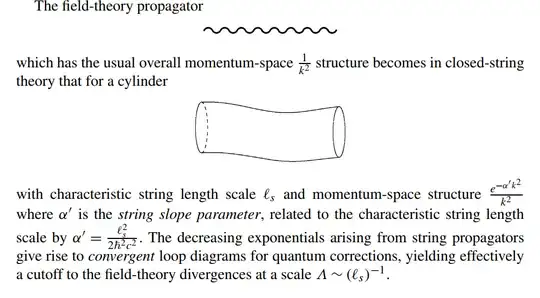I was reading Quantum Gravity and Quantum Cosmology (edited by Gianluca Calcagni, Lefteris Papantonopoulos, George Siopsis, and Nikos Tsamis, p. 6), and I came across this interesting statement about how the usual propagator in field theory, $\frac{1}{k^2}$, gets modified in string theory. Specifically, for a closed string propagating on a cylinder, the propagator takes the form:
$$\frac{e^{-\alpha' k^2}}{k^2}$$
where $\alpha'$ is related to the string length scale $\ell_s$. The key thing that stood out to me was how this introduces an effective cutoff, which apparently helps with divergences in quantum gravity.
Now, I’ve been trying to understand how exactly string theory deals with the problems that show up in standard covariant quantization of gravity. In the usual approach, we linearize GR and apply second quantization, leading to a non-renormalizable theory that blows up at two-loop order and beyond. But here, the string length scale seems to regulate things naturally. I want to ask two question about this specifically
How these cutoff cures divergences in two loop and higher diagram
- I get that the exponential suppression tames high-momentum contributions, but does it fully remove the divergences at two loops and beyond?
- Is there an explicit calculation somewhere that shows how string amplitudes remain finite due to this effect?
Origin of this exponential factor
- A lot of books mention it, but I haven’t seen a full derivation. Is there a simple way to see why the string propagator picks up this form?
- Is it coming from the Polyakov path integral formulation, or something more fundamental about the extended nature of strings?
- Ashoke Sen's lectures on string theory suggested that such a suppression is seen when we express everything from spacetime point of view rather than world sheet point of view. He said that the source of these exponential suppression is the vertex factor in String Field Theory. Any source which mentions this argument with some calculation?
I’ve checked Polchinski’s String Theory, Green-Schwarz-Witten’s Superstring Theory, and Becker-Becker-Schwarz’s String Theory and M-Theory, but they all gloss over the derivation. One solution that comes to mind is suggested in the textbook String Field Theory by Erbin as: $$\frac{1}{k^2}=\int_0^\infty ds e^{-sk^2}$$ Since, string theory does not allow $s\to0$ due to modular invariance, so we replace the lower limit of integral. If I replace lower limit to $\alpha'$ then I get what I wanna see. But this seems artificial.
If anyone has a reference that actually works this out in detail, I’d really appreciate it!
